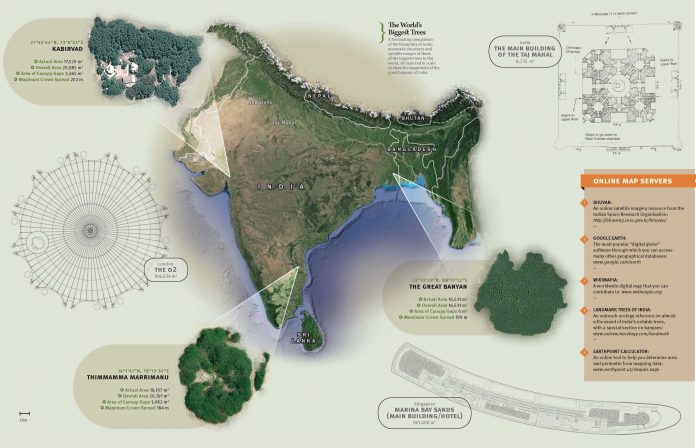Asia is a land of superlatives – the largest countries, the most populous nations, the highest mountains, and the lowest regions. It’s a much lesser-known fact, however, that the continent is also home to the most expansive trees on the planet – the sprawling, colossal, banyans of India. (Text by YD Bar-Ness)
These trees are not just spectacularly large organisms; they are also living history, ancient landmarks and ambassadors from the natural world.
What’s a Superlative Tree? It’s easy to get excited about titanic living things. While we may ourselves be massive creatures relative to the microbes that dominate the planet, we find ourselves in awe of a tree that stands over our heads. But what makes an individual plant superlatively sized?
To start with, what’s an individual? Things are made complicated by the fact that trees are modular organisms, with differing realities of individuality and sexuality. Plants can form clonal colonies, which propagate from roots, branches, or broken pieces, and they can also form multi-stemmed structures, as opposed to the more familiar upright single stem. A single vine can grow to a great linear extent, but will look less impressive than a stout wooden tree. And, critically, we are only seeing half the picture – it’s impossible to measure the root structure of a living tree with any degree of precision – nobody knows what massive roots grow beneath the ground!
If you start with the perspective that a tree is a single-stemmed, upright individual, then some of the more notable superlative trees include the largest tree by trunk wood volume: a giant sequoia (Sequoiadendron ggiganteum), encompassing 1,487 cubic metres, in the California mountains of the USA; the world’s tallest known tree: a coastal redwood (Sequoia sempervirens), also in California, at 115.56 metres above the ground; the tallest flowering plant (and the tallest in the Southern Hemisphere): a Tasmanian oak (Eucalyptus regnans), reaching 99.6 metres into the sky; the largest single trunk diameter: the Glencoe Baobab (Adansonia digitata) of Limpopo, South Africa, with a 15.9-metre diameter. This last tree, however, has recently formed a split down the centre. Does that mean it should be removed from the list? It’s up to you: diameters can be tricky to measure and depending on your approach, there are other candidates around the world.
If you expand your definition to include the largest known clonal tree – composed of separate genetically identical stems – then you encounter the Pando Aspen Grove, which covers 43 hectares of ground in the American Rocky Mountains in some 47,000 tree stems of Populus tremuloides.
A small but dedicated global community of enthusiasts records and compares the dimensions of individual trees, always seeking the largest, tallest, fattest and broadest. Of course, the numbers change, as trees grow, decline and die, and the rankings of trees, therefore, changes as well. Previously, these measurements have required precision survey tools, rangefinder lasers and sometimes even technical tree climbing. However, with freely available software, you can now join the ranks of the big-tree hunters through online digital mapping and a citizen science mindset.
The Giant Banyans of India
To me, the most interesting, historical, challenging and tenacious examples of superlative arboreal growth are the intricate, impossibly complex networks of wood formed by the tropical genera of fig trees, Ficus. They reach their structural climax in the species Ficus benghalensis and the most impressive individuals, surprisingly, live in close and intimate contact with humans in India, one of the most populous nations on Earth.
If you define “largest” by the crown coverage of a single individual tree, as measured in land area covered, then it appears that these are the largest trees in the world.
Results
The world’s largest known living tree, as measured by crown coverage, is an Indian giant banyan known
as Thimmamma Marrimanu (14°1’41″N, 78°19’30″E), covering 19,107 square metres of the Earth’s surface. (For comparison, the main building of the Taj Mahal covers only 4,225 square metres.)
This tree in Southern India, sprawling below steep granite hills, is not well known outside of Indian botanical circles, but it is indeed one of the world’s superlative organisms. It was planted more than six centuries ago by a woman named Thimmamma. She is remembered for her devotion as a wife – she performed self-immolation, or sati, by throwing herself on her husband’s funeral pyre. A sign at the site tells us that it covers 25,000 square metres and boasts more than 1,650 stems. Judging from the aerial imagery, this seems to be an overestimate.
The tree was substantially damaged by storms in 1850 and large pieces of broken wood are scattered within, but is actively recolonising the gaps.
The next largest tree by net coverage, at 17,520 square metres, is the Kabirvad (21°45’44″N, 73°8’33″E) on the Narmada River. It is also the tree with the broadest canopy in the world, with a maximum horizontal spread of 203 metres. This tree has a substantial temple within that occupies 15 percent of the interior. If we do not subtract this from our calculation, the Kabirvad is the largest tree in the world, with an expanse of 20,985 square metres.
The third largest, at 16,531 square metres, is the famous Great Banyan of the Howrah Botanical Gardens
(22°33’39″N, 88°17’12″E) in Kolkata, West Bengal. This 250-year-old tree is visited regularly by tourists and is lovingly tended by the gardeners. It lives in the fertile soil of the Ganges Delta, and is one of the country’s most famous trees.
There are still other giant banyans out there: there are many more in India that are of great size and there could be even larger trees hiding in the world’s tropical rainforests, unknown to humanity.
Check out the rest of this article in Asian Geographic No.104 Issue 3/2014 here or download a digital copy here











